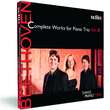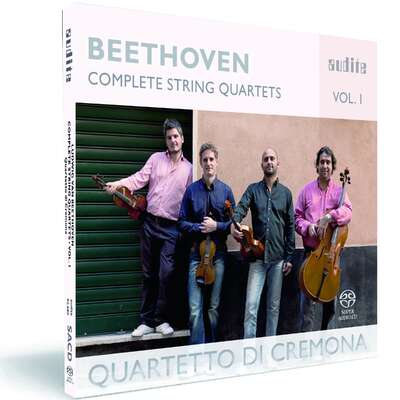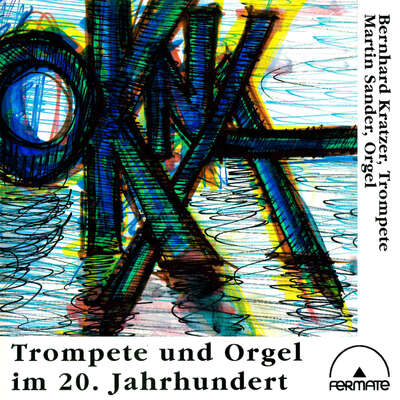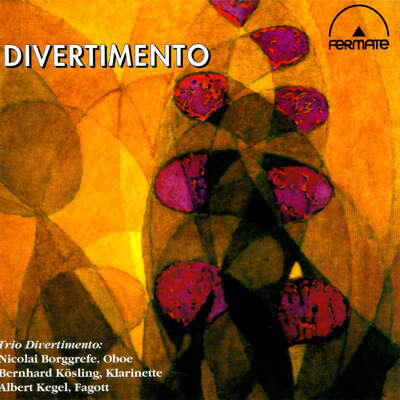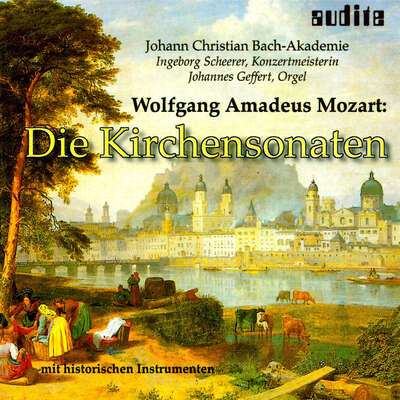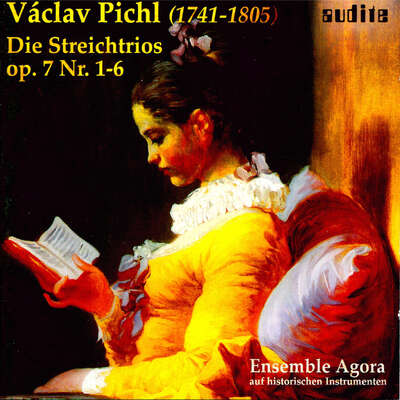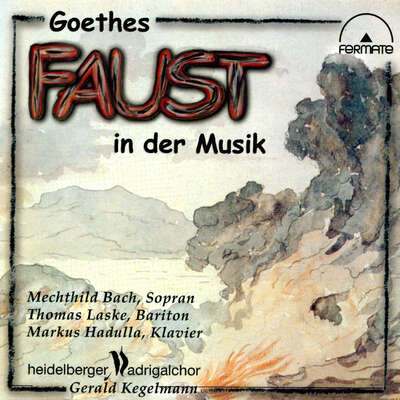
Fortsetzung der Gesamtedition der Werke für Klaviertriobesetzung: Zwei Schlüsselwerke Beethovens, ergänzt durch die unterschätzten Variationen op. 44.mehr
Fortsetzung der Gesamtedition der Werke für Klaviertriobesetzung: Zwei Schlüsselwerke Beethovens, ergänzt durch die unterschätzten Variationen op. 44.
Details
| Ludwig van Beethoven: Complete Works for Piano Trio - Vol. 3 | |
| Artikelnummer: | 97.694 |
|---|---|
| EAN-Code: | 4022143976949 |
| Preisgruppe: | BCA |
| Veröffentlichungsdatum: | 29. April 2016 |
| Spielzeit: | 75 min. |
Zusatzmaterial
Informationen
Die dritte Folge der Gesamtaufnahme von Werken für Klaviertriobesetzung des Schweizer Klaviertrios präsentiert mit dem 1795 veröffentlichten Klaviertrio c-Moll op. 1, Nr. 3 ein Schlüsselwerk Beethovens, das über die Gattung des Klaviertrios hinaus für Beethovens Musik zentrale Bedeutung gewonnen hat. Bereits hier erprobte Beethoven den Ansatz einer Verdichtung der thematischen Bezüge, um eine zwingende formale und dramatische Handlung zu schaffen, die gleichzeitig ein breites Ausdrucksspektrum ermöglicht. Das 1808 komponierte fünfte Klaviertrio Es-Dur op. 70, Nr. 2 geht noch einen entscheidenden Schritt darüber hinaus: In ihm brechen sich das Unerwartete und eine Subjektivierung Bahn, die auf die romantische Generation großen Einfluss genommen hat. Die leider nur als Nebenwerk angesehenen 14 Variationen über ein eigenes Thema in Es-Dur op. 44 zeigen dagegen einen Komponisten, der ebenso gewitzt wie kalkuliert einem banalen Dreiklangs-Thema eine kaum fassbare Fülle an Variationen und Metamorphosen entlockt - gewissermaßen eine „Fingerübung", die aber in jedem Moment die von den Zeitgenossen gleichermaßen bewunderte wie als rätselhaft empfundene Überlegenheit des Tonkünstlers Beethoven offenbart.
Besprechungen
Musica | N. 331 - NOVEMBRE 2021 | Stefano Pagliantini | 1. November 2021
[…] Certo, sul mercato l’offerta è ampia, anche tra le uscite recenti, tra cui si ricordano almeno quella con Daniel Barenboim, Kian Soltani eMehr lesen
Di questa interpretazione si ricorderanno in particolare le 14 variazioni op. 44 per l’esuberanza, il divertito gioco di scambi e di incroci tra i tre strumenti e la generale brillantezza che caratterizza la composizione.
American Record Guide | September / October 2016 | Gregory Hamilton | 1. September 2016 | Quelle: http://www.ameri...
This series presents the Beethoven trios not in chronological order, but as integral concert programs. This release has a very lovely ambience andMehr lesen
www.musicweb-international.com | Tuesday August 23rd | Colin Clarke | 23. August 2016 | Quelle: http://www.music...
My Musicweb International colleague David Barker reviewed Volume 2 of this five-disc series in December 2015 (who knows, maybe even concurrently withMehr lesen
Perhaps as an extension of this informed approach, the booklet notes on the works themselves are remarkably detailed. Such attention to detail extends to the performances themselves, all of them caught in a fabulous, perfectly-placed recording.
The Piano Trio, Op. 1/3, in Beethoven’s favourite C minor key, is a major four-movement statement which holds in place of a slow movement an “Andante cantabile con variazioni,” which actually here is the highlight of the performance. The five variations are expertly characterised, and they are not afraid of internalising. Sighing phrases are deliciously done; the group is not afraid of drama, also. And excellent programming, to boot, in that this prefigures the larger set of Variations to follow (Op. 44). The Menuetto has its more restless moments (deliberately coming across as a touch off-centre), but it has its beauties, also, not least the feather touch of pianist Martin Lucas Staub in the rapid upward-reaching gestures. The finale’s strong outbursts of energy are perfectly judged.
Beethoven’s Variation sets always hold much interest as well as delight, and Op. 44 is no exception. The E flat major theme is simple and bare-boned, given out in mezzo-staccato and in octaves, primed for exploration, and the succeeding 14 Variations include much eloquence from the present performers, not least from Sébastien Singer’s cello. Finally, the Piano Trio No. 6 of 1808, also in E flat. The skeletal Poco sostenuto opening is taken at a very flowing tempo, following Czerny, and enables the Allegro ma non troppo main body of the movement to emerge naturally. The allegro itself holds some lovely sighing gestures, while the second movement Allegretto holds some real grit. The ensuing Allegro ma no troppo is a dream, with a terrific sense of flow; the finale feels perfectly calculated here, from its baseline tempo through its exploration of the varying terrain. No mere throwaway finale, this movement balances the depth of the first movement. The Swiss Piano trio gives a remarkably satisfying account of this rewarding piece.
A lovely release, one that shows the dynamism of thee works. Collectors will doubtless have their favourites in this repertoire, for many it will be the Beaux Arts Trio, although I hold a particular affection for Kempff with Szeryng and Fournier on DG in the two main Trios.
WDR 3 | TonArt | 21.06.2016 | 21. Juni 2016 BROADCAST
Sämtliche Klaviertrios von Beethoven nimmt das Schweizer Klaviertrio auf. Gerade ist Volume 3 des Projektes erschienen. Christoph Vratz hat die CDMehr lesen
De Gelderlander | 18 mei 2016 | Maarten-Jan Dongelmans | 18. Mai 2016 Klassiek: Het Swiss Piano Trio biedt het beste van twee werelden
Er zijn meerdere topnamen van de complete pianotrio's van Ludwig van Beethoven (1770-1827) – ik hoef alleen maar de naam van het Beaux Arts Trio te noemen – maar mijn voorkeur gaat uit naar deze in januari 2015 gestarte reeks van het Duitse kwaliteitslabel Audite. [...] Lering trekken uit de muziekwetenschap en dat combineren met ultiem speelplezier: het Swiss Piano Trio biedt het beste van twee werelden.Mehr lesen
Fanfare | October 2016 | Jerry Dubins
I’m not sure what happened to Volume II in the Swiss Piano Trio’s ongoing Beethoven cycle, but in 39:1 I gave high marks to the ensemble’sMehr lesen
In keeping to its commitment to record Beethoven’s complete works for violin, cello, and piano—as have the Trio Élégiaque and others—the Swiss Piano Trio here includes one of the composer’s early, offbeat works, the Variations on an Original Theme, op. 44. The advanced opus number reflects the date of publication by Franz Hoffmeister in 1804, a dozen years after the piece is believed to have been written in 1792. If the theme is “original” (questionable to begin with), little else about the score is.
Beethoven borrowed heavily from Carl von Dittersdorf’s opera Das rote Käppchen (The Little Red Cap). Nonetheless, as Richard Rodda wrote, “Beethoven worked 14 conventional variations and a coda into this lean material, allowing all three instruments leading moments and eliciting some deeper emotions with two minor-key episodes. It’s an example of Beethoven spinning gold, or at least silver, from humble materials.” Beethoven’s first works to receive official publication, his op. 1, was a set of three piano trios in 1795, but it’s known that they were first performed in the house of Prince Lichnowsky, their dedicatee, in 1793, which means they had to be composed around the same time as the foregoing variations. Third in the set, the C-Minor Trio already exhibits the emotional intensity and angst that so shocked his early Viennese audiences and that catapulted his music from polite drawing-room society into the public arena.
Some 16 years later, in 1808, Beethoven set about composing another two piano trios, this time published as a pair under the opus number 70. It’s rather amazing to think about the works Beethoven turned out in those intervening years, not just the number of them, but the import of those works to music history—six of his nine symphonies, all of his early and middle string quartets, 23 of his 32 piano sonatas, all but the last of his concertos, and the list goes on. But the second of Beethoven’s two op. 70 Piano Trios, not unlike several of his other works, not to mention works by other composers as well, has been relegated to a lower status simply due to its proximity to another like work made popular by a nickname. Op. 70/1, dubbed the “Ghost,” enjoys greater recognition because of its nickname.
Personally, I’ve always found its nameless companion, op, 70/2, included on the present release, the more interesting of the two works. For one thing, Beethoven devotes the first half of the development section to exploring the first movement’s second theme, unusual enough in itself, but what he does with it is truly breathtaking, as he passes phrases back and forth between the instruments while modulating through a number of keys. Then midway through, there’s a false recapitulation that fools you into thinking the reprise has arrived when, in fact, the development still hasn’t run its course. The following Allegretto is one of those enigmatic scherzo-like movements that begins almost flippantly and then turns suddenly militant and menacing. Is it a joke? What does it mean? The third movement, another Allegretto, this time ma non troppo, is perhaps the most beautiful movement of all; if not that, then surely it points to those moments in Beethoven’s late piano sonatas and string quartets in which he achieves a sense of ecstatic expectancy and quiet rapture in phrases that seem strangely incomplete, yet searching for fulfillment. The principal theme of this Allegretto poses the same sense of yearning for some resolution that Beethoven never gives us, as he repeats the melody over and over again. The finale is an explosion of pure unbridled joy that wants to break the bonds of the instruments that constraint it.
With this latest release by the Swiss Piano Trio I’m prepared to double down, even triple down on every admiring and praiseworthy thing I’ve said about this ensemble. For some time now, I’ve been extolling the virtues of the Trio Élégiaque’s Beethoven piano trio cycle, and I’m not about to change my mind about it, but I will say that the Swiss Piano Trio’s cycle is shaping up to be every bit as superb. These are exceptionally gifted players who perform with unerring technical perfection and instinctive musical intelligence that never misjudges the significance of a single note. Very, very strongly recommended.
Neuigkeiten
[…] Certo, sul mercato l’offerta è ampia, anche tra le uscite recenti, tra...
I’m not sure what happened to Volume II in the Swiss Piano Trio’s ongoing...
This series presents the Beethoven trios not in chronological order, but as...
My Musicweb International colleague David Barker reviewed Volume 2 of this...
Klassiek: Het Swiss Piano Trio biedt het beste van twee werelden
